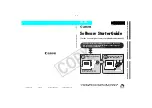
Using Replication for Scale-Out
1489
• If you used
mysqldump
to create the database snapshot on your master, you could edit the dump
file text to change the engine type used on each table.
Another alternative for
mysqldump
is to disable engine types that you do not want to use on the
slave before using the dump to build the data on the slave. For example, you can add the
--skip-
innodb
[1236]
option on your slave to disable the
InnoDB
engine. If a specific engine does not exist
for a table to be created, MySQL will use the default engine type, usually
MyISAM
. (This requires that
the
NO_ENGINE_SUBSTITUTION
[537]
SQL mode is not enabled.) If you want to disable additional
engines in this way, you may want to consider building a special binary to be used on the slave that
only supports the engines you want.
• If you are using raw data files (a binary backup) to set up the slave, you will be unable to change the
initial table format. Instead, use
ALTER TABLE
to change the table types after the slave has been
started.
• For new master/slave replication setups where there are currently no tables on the master, avoid
specifying the engine type when creating new tables.
If you are already running a replication solution and want to convert your existing tables to another
engine type, follow these steps:
1. Stop the slave from running replication updates:
mysql>
STOP SLAVE;
This will enable you to change engine types without interruptions.
2. Execute an
ALTER TABLE ... ENGINE='engine_type'
for each table to be changed.
3. Start the slave replication process again:
mysql>
START SLAVE;
Although the
storage_engine
[497]
and
table_type
[499]
variables are not replicated, be aware
that
CREATE TABLE
and
ALTER TABLE
statements that include the engine specification will be
correctly replicated to the slave. For example, if you have a CSV table and you execute:
mysql>
ALTER TABLE csvtable Engine='MyISAM';
The above statement will be replicated to the slave and the engine type on the slave will be converted
to
MyISAM
, even if you have previously changed the table type on the slave to an engine other than
CSV. If you want to retain engine differences on the master and slave, you should be careful to use the
storage_engine
[497]
variable on the master when creating a new table. For example, instead of:
mysql>
CREATE TABLE tablea (columna int) Engine=MyISAM;
Use this format:
mysql>
SET storage_engine=MyISAM;
mysql>
CREATE TABLE tablea (columna int);
When replicated, the
storage_engine
[497]
variable will be ignored, and the
CREATE TABLE
statement will execute on the slave using the slave's default engine.
16.3.3. Using Replication for Scale-Out
You can use replication as a scale-out solution; that is, where you want to split up the load of database
queries across multiple database servers, within some reasonable limitations.
Because replication works from the distribution of one master to one or more slaves, using replication
for scale-out works best in an environment where you have a high number of reads and low number of
writes/updates. Most Web sites fit into this category, where users are browsing the Web site, reading
articles, posts, or viewing products. Updates only occur during session management, or when making a
purchase or adding a comment/message to a forum.
Summary of Contents for 5.0
Page 1: ...MySQL 5 0 Reference Manual ...
Page 18: ...xviii ...
Page 60: ...40 ...
Page 396: ...376 ...
Page 578: ...558 ...
Page 636: ...616 ...
Page 844: ...824 ...
Page 1234: ...1214 ...
Page 1427: ...MySQL Proxy Scripting 1407 ...
Page 1734: ...1714 ...
Page 1752: ...1732 ...
Page 1783: ...Configuring Connector ODBC 1763 ...
Page 1793: ...Connector ODBC Examples 1773 ...
Page 1839: ...Connector Net Installation 1819 2 You must choose the type of installation to perform ...
Page 2850: ...2830 ...
Page 2854: ...2834 ...
Page 2928: ...2908 ...
Page 3000: ...2980 ...
Page 3122: ...3102 ...
Page 3126: ...3106 ...
Page 3174: ...3154 ...
Page 3232: ...3212 ...
















































